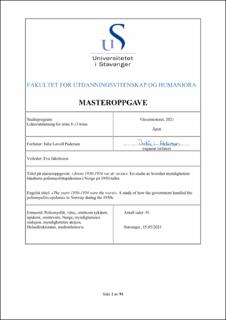«Årene 1950-1954 var de verste». En studie av hvordan myndighetene håndterte poliomyelittepidemien i Norge på 1950-tallet.
| dc.contributor.advisor | Jakobsson, Eva | |
| dc.contributor.author | Pedersen, Julie Løvoll | |
| dc.date.accessioned | 2021-09-03T16:34:15Z | |
| dc.date.available | 2021-09-03T16:34:15Z | |
| dc.date.issued | 2021 | |
| dc.identifier | no.uis:inspera:80599373:9789428 | |
| dc.identifier.uri | https://hdl.handle.net/11250/2773518 | |
| dc.description.abstract | Denne masteroppgaven fokuserer på den smittsomme sykdommen poliomyelitt, og hvordan de norske myndighetene reagerte og håndtere et epidemisk utbrudd i Norge. I sentrum for undersøkelsen står utbruddet på 1950-tallet for det er flere medisinere og historikere som sier at det er de verste epidemiårene. Oppgavens problemstilling er: Hva var myndighetenes reaksjon og aksjon på poliomyelittepidemien i Norge på 1950-tallet? Den historiske analysen fokuserer på poliomyelittepidemiene på 1950-tallet og hvordan myndighetene prøvde å håndtere smittespredningen. Hvilke tiltak kunne myndighetene iverksette for å forhindre smittespredning? Hvordan brukte de hjelpemidlene og ressursene de hadde tilgang på? Og hva eksisterte av lovverk om epidemiske sykdommer? Ble det etterhvert behov for nye lovbestemmelser? For å svare på problemstillingen er det blitt hentet en del materiale fra Stavanger byarkiv, samt digitaliserte avisartikler fra Nasjonalbiblioteket. Det har vært vesentlig for oppgaven å se på tidligere medisinvitenskapelige oppfatninger fra 1868 og utover. Det er derfor blitt henvist til tidligere forskning fra et historisk-medisinskperspektiv. I begynnelsen var målet om å bidra til ny kunnskap om et samfunns svar på en epidemis utfordringer, men på grunn av koronapandemien vil det være mulig å trekke linjer og gjenkjenne seg i utfordringene. Vi lever nå i 2021 i en lignende situasjon og de aller fleste som leser denne oppgaven vil kunne gjenkjenne seg i det som blir skrevet eller gjort for nesten 70 år siden. | |
| dc.description.abstract | This master’s thesis focuses on the infectious disease poliomyelitis, and the reaction and handling by the Norwegian government following the epidemic outbreak in Norway. Most emphasis of the investigation will be given to the outbreak in the 1950s, which many doctors and historians consider the worst years of the epidemic. The main research question is: What were the government’s reaction and action to the poliomyelitis epidemic in Norway in the 1950s? The historical analysis therefore, focuses on the poliomyelitis epidemic and how the government tried to handle the spread of infection. What measures could the government put in place to stop the transmission of the disease? How did they use the tools and resources available to them? And what existed of legislation concerning epidemic diseases at the time? Was there any new legal provisions? To answer the research question, this thesis has used material from Stavanger city archive, as well as digitalized newspaper articles from National Library of Norway. It was essential for the thesis to look at earlier perceptions in the field of medical studies from 1868 and onwards. Therefore, references are made to earlier research from a historical-medical perspective. In the beginning, the goal of the research paper was to contribute towards knowledge of a society’s response to challenges stemming from an epidemic. However, following the Covid-19 pandemic, the thesis is perhaps more relevant than ever, and one can certainly draw lines between the past and present, recognize the challenges facing society in 2020/21. To the point where most people reading this thesis will identify with what was written or done almost 70 years ago. | |
| dc.language | nob | |
| dc.publisher | uis | |
| dc.title | «Årene 1950-1954 var de verste». En studie av hvordan myndighetene håndterte poliomyelittepidemien i Norge på 1950-tallet. | |
| dc.type | Master thesis |
Files in this item
This item appears in the following Collection(s)
-
Student papers (HF-IKS) [903]
Master- og bacheloroppgaver i Lesevitenskap / Literacy studies / Historiedidaktikk
